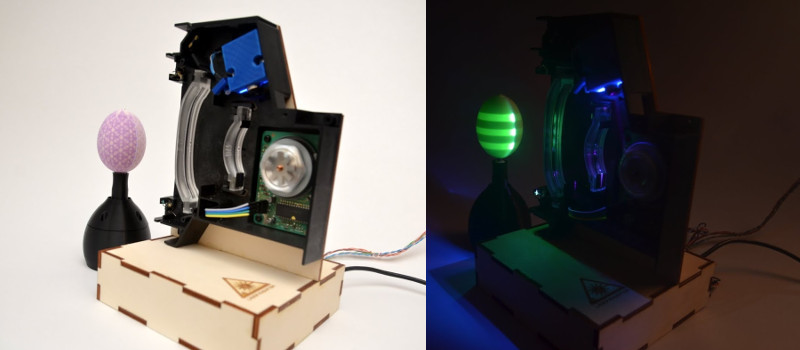Photochromic paint is pretty nifty – under exposure to light of the right wavelength, it’ll change colour. This gives it all kinds of applications for temporary displays. [Jiri Zemanek] decided to apply photochromic paint to an egg, utilising it to create stroboscopic patterns with the help of a laser.
Patterns for the egg are generated in MATLAB. A Discovery STM32 board acts as a controller, looking after the laser scanner and a stepper motor which rotates the egg. A phototransistor is used to sync the position of the laser and the egg as it rotates.
The photochromic paint used in this project is activated by UV light. To energize the paint, [Jiri] harvested a violet laser from a Blu-ray player, fitting it to a scanning assembly from a laser printer. Instead of scanning the laser across an imaging drum, it is instead scanned vertically on a rotating egg. Patterns can then be drawn on the egg, which fade over time as the paint gives up its stored energy.
[Jiri] exploits this by writing a variety of patterns onto the egg, which then animate in a manner similar to a zoetrope – when visualised under strobing light, the patterns appear to move. There are also a few holiday messages shown for Easter, making the egg all the more appropriate as a billboard.
If you like the idea of drawing on eggs but are put off by their non-uniform geometry, check out the Egg-bot. Video below the break.
















replace: Waveform with: wavelength. Pretty different things!
thou must sing to thy egg.
/fixed
Huh, that’s almost the same purple of the classic KCl scotophor… but since it’s being charged with UV, not electrons, I guess it has to be something different.
Phoooa, nice!
Eggsemplary.
Eggscellent.
Eggsemplary in an eggsellent way.
eggsactly
Eggstremely witty of you all
I shell remember these eggsamples.
It was eggspertly done.
What if you used the inside surface, of something that was like transparent, and then coated it with some kind of quicker reactive photochromic stuff, like phosphor, and drew a full picture, like 30 times a second, that you could like animate electonically, and have some method of wireless delivery….
That’s ridiculous! There’s no way that’ll ever replace the LCD and delivery of video over the Internet. Way too bulky and complicated. Wireless? Seriously?
It would be like dieselpunk youtube, but maybe you’d have to replace the laser beam with another kind of beam they could make back then, like maybe thermionically emitted electrons.
I don’t even understand why wires are needed. Delivering this, transparent, electronically animated egg could be done with a simple cardboard box and packaging material like everything else. No wires needed.
photochromic eggs and ham?
I know what it means, but this made me laugh:
“under exposure to light of the right wavelength, it’ll change colour”
obviously everything changes colour under exposure to light of the right wavelength. I know, I’m a nerd.